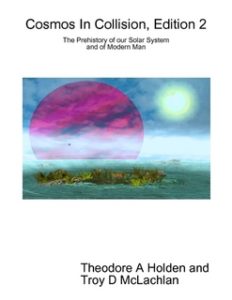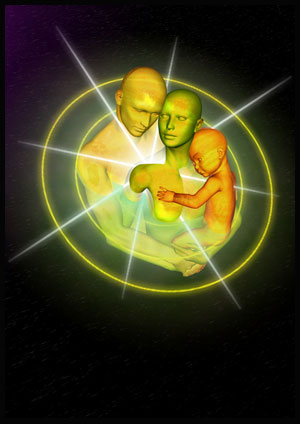 A time of bliss and plenty, the fabled Golden Age of mankind existed for the duration of Saturn’s precarious life as Earth’s polar sun – a position threatened by the unstable nature of the newly-born planet Venus and the encroachment of the Sun and its own planetary satellites.
A time of bliss and plenty, the fabled Golden Age of mankind existed for the duration of Saturn’s precarious life as Earth’s polar sun – a position threatened by the unstable nature of the newly-born planet Venus and the encroachment of the Sun and its own planetary satellites.
(continued from From Purple Haze to Golden Days)
While initial contact between the plasma sheaths of both the Saturnian system and the Sun had been catastrophic for life on Earth, it also brought about the impetus for the rise of civilisation and a golden age of exploration. Time and measure could now be put to use in surveying a world which would give of its bounty freely due to the continued radiating warmth of the flared Saturn.
But that was not the end of cataclysmic events stalking the earth. What was known as the Golden Age would, in fact, be permeated with catastrophic episodes that would eventually led up to one of the greatest cataclysmic events in human experience – the Great Deluge.
Under a New Sun
In the time after Saturn experienced its first contact with the electrical influence of the Sun, the new-look Saturnian system spiralled away back into interstellar space. As noted before, the Sun now could be seen from Earth as a distant light rising in the east and setting in the west. Intense auroral activity created various permutations in the pillar-like Birkeland current that connected Earth to the northern heavenly abode of Saturn. Rock art, or petrogylphs, have captured these permutations in abundance and provide a useful view of the celestial sights witnessed by man during this golden age.
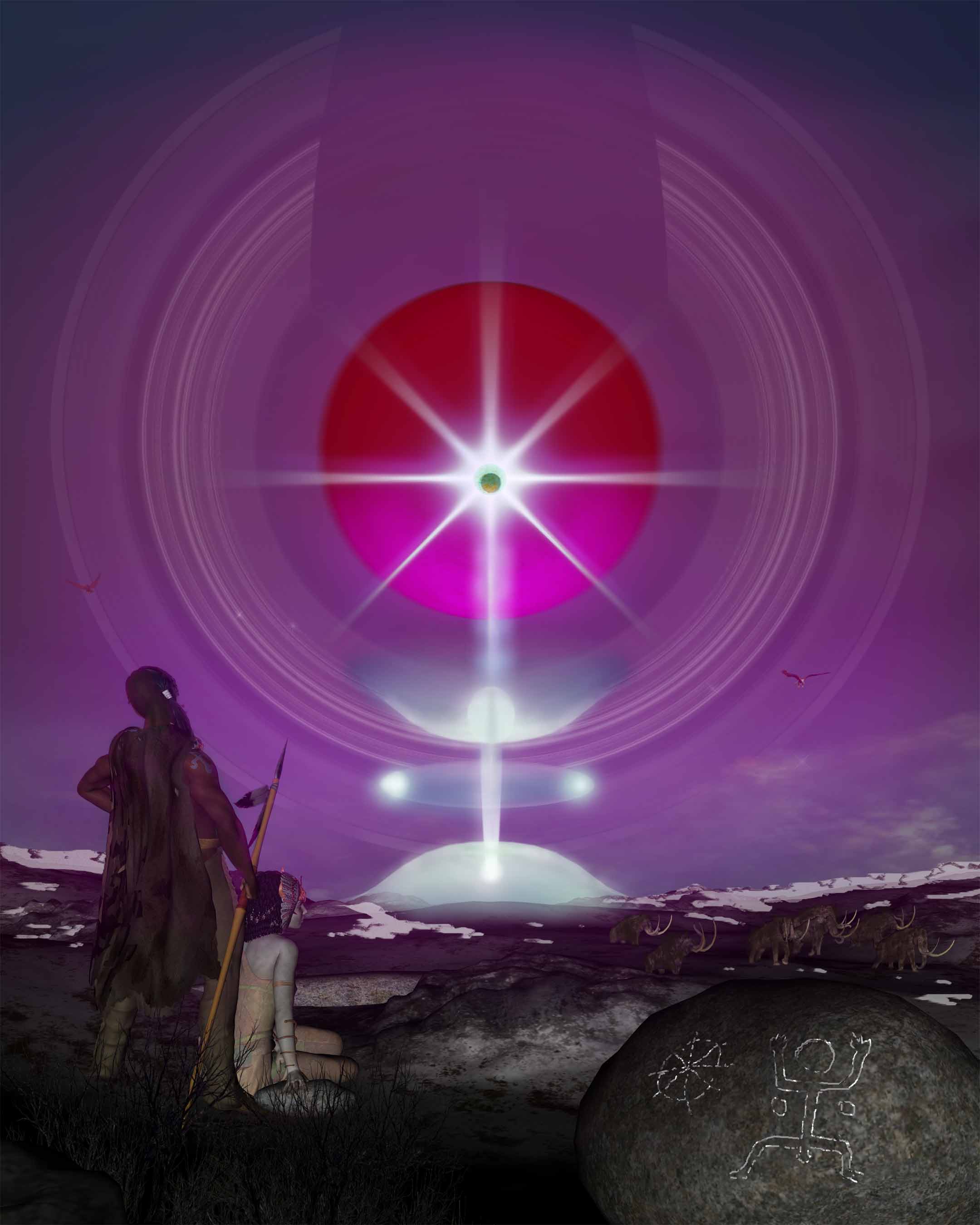
The ‘pinch effect’ on plasmas can lead to a shape that would have looked like a squatting man with arms held aloft in support of the heavens (see pictures below for image of plasma in a laboratory environment). The characteristic rendition of this auroral effect has been etched into rock faces the world over.
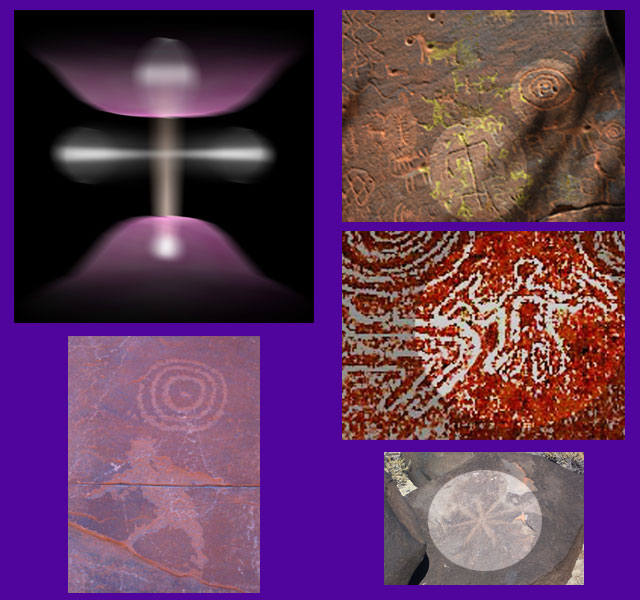
Top left: A re-creation of the basic ‘squatter man’ pinch effect captured in a plasma laboratory experiment. Top right: American petroglyphs with distinctive squatting man images. Middle right: Spanish squatter man. Bottom right: American star burst pattern. Bottom left: American squatter man under concentric circles.
The emergence of totems in various cultures also reflects a heritage going back to the Golden Age when Saturn’s rings appeared as outstretched wing-like crescents atop a glowing ladder.

A speculative impression of the classic totem pole’s legacy as representation of the Earth’s Birkeland current. The twisting spiralling nature of Birkeland filaments reaching out into space would sometimes terminate in a fork-like effect. This is clearly represented in various rock art petroglyphs as depicted in the above right insert.
However, Saturn’s spiral journey through space meant that a return to the point of contact with the Sun’s heliosphere was inevitable for Saturn and its southerly string of planets. How many times this process repeated itself is unclear, but sufficient to say that each time an approach was made catastrophic events, deluges, global firestorms and massive earth changes could be expected to unfold in both the heavens and on the Earth.
The Golden Age polar configuration of the Saturn system
 Though the Ancients would not have perceived this as such, the Saturnian polar configuration now consisted of four planets from Earth’s perspective. First in line from the northern top of the configuration was, of course, Saturn, itself now surrounded by frozen water rings and orbited by nine small “followers”. It still glowed brilliantly after its energising contact with the Sun’s heliosphere.
Though the Ancients would not have perceived this as such, the Saturnian polar configuration now consisted of four planets from Earth’s perspective. First in line from the northern top of the configuration was, of course, Saturn, itself now surrounded by frozen water rings and orbited by nine small “followers”. It still glowed brilliantly after its energising contact with the Sun’s heliosphere.
Next in line was the feminine Venus, the Evening Star and bride of Saturn, a planet that would display wonderful streamers of light when electrically excited that were seen as four and eight-pointed star bursts radiating out from Saturn’s centre. Whether Venus was ejected by Saturn during the first flare-up or had always been there is not fully understood, but the Chaos Monster that had heralded her appearance was a direct result of Venus’ coming to life.
After Venus came masculine Mars, red in colour and seemingly enveloped in the womb of Venus. Mars was the Morning Star, son of Saturn and viewed as the archetype rebellious hero. Unseen during the Purple Dawn, the massive electrical discharging betwee Saturn and Mars had obliterated Mars’ atmosphere turning this planet’s surface red.
These three, Saturn, Venus and Mars, formed the heavenly abode, an abode that could only be reached via the heavenly ladder that was the giant plasma Birkeland current that rose from Earth’s north pole, the Axis Mundi of legend. Earth, the last in this string of planets, was now the humble abode of mere mortals.
Inter-planetary warfare
It was during these times that the Ancients witnessed the beginnings of discord between these godlike planets and began to fear destructive visitations by these celestial bodies. The planet Mars, the dark pupil in the All-Seeing Eye that was Saturn, made close approaches to Earth along the length of the visible yet translucent plasma current joining the string of planets. Looming large it would bombard the Earth with its martian rocks and thunderbolts before re-ascending to its position under Venus which would itself flare and stream light in awesome displays of cosmic lightening and beauty.
At least one full-on thunderbolt-laden battle was waged between Venus and Mars during which Mars suffered a great scarring injury that we now see today on its surface as the huge chasm called Valles Marineris. The warrior god with the scared face had earned his battle honours!
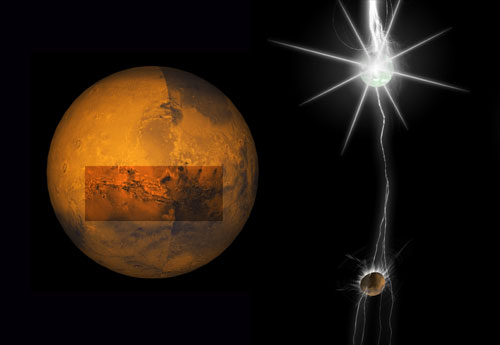
The giant scar of the Valles Marineris on the face of Mars, the result of extreme inter-planetay electrical arcing between a newborn Venus and Mars. Seen from Earth, these terrifying celestial battles have been etched onto the collective memories of mankind in their depictions of Mars as a scarred warrior hero and god of war.
Such episodes were looked on with abject terror by Earth’s inhabitants and probably accounted for various extinction events in the earth’s history due to the destructive effects of these planetary fluctuations and close encounters.
Also, and largely due to the day/night effect of the encroaching Sun’s equatorially oriented light source, life on Earth under the Saturnian sun began to look different. Gone was the luxuriant reddish and purple hue of the planet’s fauna and atmosphere now replaced by the more familiar green cast of Earth’s forests and jungles thanks to the different radiation frequencies caused by the flare up. Deserts began to appear and the oceans started to rise. More and more distant stars could be seen at night and the various constellations began to take shape.

Saturn and the Axis Mundi at the height of the Golden Age (midday). Auroral activity at he base of the Axis Mundi would have created the illusion of a mountain from which the ladder to heaven ascended. This would be known as the mountain of the gods to most cultures and most famously as Mount Olympus to the Greeks.
The slide towards catastrophe
Gravity during the Golden Age started to get heavier now that two suns shed their energies over the earth, with the planet possible increasing in actual size due to its increased energy absorption being converted into mass (E= mc2). Massive fissures and cracks would have appeared on Earth as a result with correspondingly dramatic increases in volcanic and earthquake activity.
Eventually Saturn and its family of planets were permanently captured by the Sun with the result that the Sun began to make a closer, yet stable and more regular passage across the sky from east to west. The Saturnian system’s polar configuration continued to persist with Saturn becoming ever dimmer during the day and starting to take on a sick, blotchy look at night. The legendary ladder to heaven that was the Birkeland current connection between Earth and Saturn started to buckle and itself oscillate giving the appearance of a decrepid figure now ruling the northern sky. Already weakened by the various episodes involving the oscillations of Mars and Venus along its length, it was only a matter of time before this inter-planetary plasma current snapped altogether and Earth would be severed forever from the Saturnian heavenly abode.
The catalyst came in the form of the Great Deluge. Doomsday had arrived.

